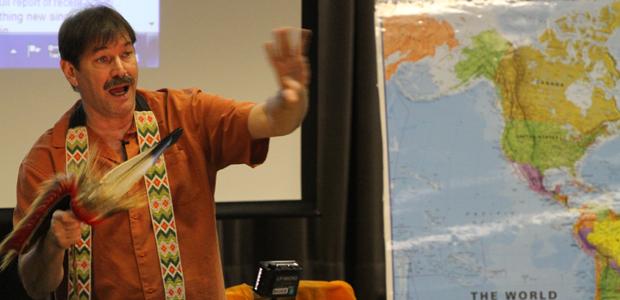According to statistics, Native Americans are the least studied cultural group in the education system. There isn’t much history pertaining to them, besides all the preconceptions that are portrayed in movies and other mediums.
With this in mind, history professor Roger Bowerman instructed a Native American cultural diversity series on May 15, in Kreider Hall to heighten awareness about the inadequate depiction of how Native Americans feel about the world and share his knowledge about their vibrant culture.
The event was at its maximum capacity filled with students and staff, with no available seats and people sitting on the walls and open floor space to hear Bowerman’s lecture.
The event was coordinated by professor J.C. Moore.
“I felt it was a necessity for a cultural diversity lecture on campus with someone with experience in the field to properly inform the students,” said Moore. “I know nothing about Native Americans and he is going to change that,” she added.
Bowerman’s interest in Native American culture sparked when he was only 8 years old. He joined a Native American dance group in the San Fernando Valley and he became fascinated in the culture.
“My brother got involved and I did anything my brother did,” he said.
Bowerman graduated from UCLA with a degree in United States history with a focus on the Native American experience.
Bowerman began teaching at Glendale College as an adjunct professor in 1979. In 1996, he was promoted to a full-time instructor. Currently, he teaches history, ethnic studies, social sciences, and is working on conducting an interdisciplinary humanities class. Bowerman was fascinated with the Native American culture during his adolescence years that he learned how to sing their cultural music. In 1969, he performed at the first national “pow wow” in Missouri.
Currently, Bowerman is looking for a publisher for a book he wrote on the Native American experience. His book focuses on how to depict the history of Native Americans, since there’s little history and documents about them. Furthermore, “I apply this method of how creative you have to be to study Native Americans and how to examine the history of indigenous people,” he said.
According to Bowerman, there are Native American products that have lost cultural value through U.S. consumerism. One example is the dream catcher. Nowadays, people purchase dream catchers because they are sought out to keep away the haunting spirits and capture horrifying dreams. However, according to the Bowerman, in native lore, dream catchers are said to work only if handcrafted by the person who is going to use it
During his presentation, Bowerman displayed several Disney animations to demonstrate how this billion-dollar industry displayed misconceptions about the role of Native Americans in society. As early as 1953, animated films such as “Peter Pan” portrayed the skin color of the indigenous people as red in the film — even though Native Americans are not born with red skin. The stereotype was implemented to show that “Indians” are grotesquely different than other races. The color red denotes anger and evilness.
Toward the end of the presentation, Bowerman costumed himself in cultural Native American attire and gave the audience a “pow wow” demonstration, a traditional dance. He performed the dance to exemplify how the media portrays the dance as a bunch of “Indians” jumping and howling, when in reality there are routines and specific moves that need to be enforced.
There are 250,000 Native Americans in the Los Angeles area, so it is vital to know about their vibrant culture, how it affects our society and how they bring diversity to this nation.
“This is part one, part two is coming in a couple of years,” said Moore.


